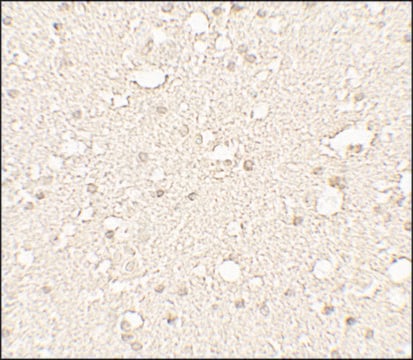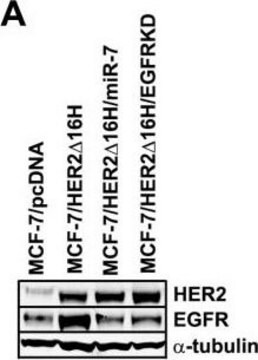CBL270-I
Anti-alpha-Tubulin Antibody, clone YOL1/34
clone YOL1/34, from rat
Synonym(s):
Tubulin alpha-1 chain, alpha-tubulin
About This Item
Recommended Products
biological source
rat
Quality Level
antibody form
purified immunoglobulin
antibody product type
primary antibodies
clone
YOL1/34, monoclonal
species reactivity
rat, mouse, human, yeast, amoeba, porcine
technique(s)
ELISA: suitable
affinity binding assay: suitable
electron microscopy: suitable
immunocytochemistry: suitable
western blot: suitable
isotype
IgG2aκ
NCBI accession no.
UniProt accession no.
shipped in
ambient
target post-translational modification
unmodified
Gene Information
Saccharomyces cerevisiae ... Tub1(854889)
human ... TUBA1A(7846)
General description
Specificity
Immunogen
Application
Western Blotting Analysis: 1 µg/mL from a representative lot detected alpha-tubulin in 10 µg of NIH/3T3 mouse fibroblast and PC12 rat pheochromocytoma cell lysates.
Affinity Binding Assay: Pig brain α-tubulin, α-tubulin/β-tubulin heterodimer, as well as α-tubulin proteolytic fragments a.a. 414-425 and a.a. 403-422, but not β-tubulin or actin, effectively competed against immobilized α-tubulin for YOL 1/34 binding (Breitling, F., and Little, M. (1986). J. Biol. Chem. 189(2):367-370).
Electron Microscopy Analysis: A representative lot immunostained microtubules of crude yeast nuclear envelope preparation (Kilmartin, J.V., et al. (1982). J. Cell Biol. 93(3):576-582).
ELISA Analysis: A representative lot detected pig brain α-tubulin by direct (non-sandwich) ELISA (Breitling, F., and Little, M. (1986). J. Biol. Chem. 189(2):367-370).
Immunocytochemistry Analysis: A representative lot immunostained fixed NIH/3T3 cells as well as yeast spheroplasts and nuclei preparations (Kilmartin, J.V., et al. (1982). J. Cell Biol. 93(3):576-582).
Immunocytochemistry Analysis: A representative lot immunostained microtubules of fixed Dictyostelium (amoeba) as well as isolated and stabilized amoeba cytoskeleton (Kilmartin, J.V., et al. (1982). J. Cell Biol. 93(3):576-582).
Western Blotting Analysis: A representative lot detected α-tubulin in spermatozoa sample from from fertile and infertile men (Breitling, F., et al. (1991). Gene. 104(2):147-153).
Quality
Western Blotting Analysis: 1 µg/mL of this antibody detected alpha-tubulin in 10 µg of HeLa cell lysate.
Target description
Linkage
Physical form
Other Notes
Not finding the right product?
Try our Product Selector Tool.
Storage Class Code
12 - Non Combustible Liquids
WGK
WGK 1
Flash Point(F)
Not applicable
Flash Point(C)
Not applicable
Certificates of Analysis (COA)
Search for Certificates of Analysis (COA) by entering the products Lot/Batch Number. Lot and Batch Numbers can be found on a product’s label following the words ‘Lot’ or ‘Batch’.
Already Own This Product?
Find documentation for the products that you have recently purchased in the Document Library.
Our team of scientists has experience in all areas of research including Life Science, Material Science, Chemical Synthesis, Chromatography, Analytical and many others.
Contact Technical Service








